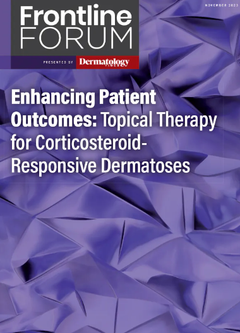
Clinical Trials of Steroidal and Nonsteroidal Treatment
Linda F. Stein Gold, MD; Jayme M. Heim, MSN, FNP-BC; and Darren West, MPAS, PA-C, review the adverse effect profiles of steroidal and nonsteroidal treatments, focusing on hypothalamic pituitary adrenal axis suppression.
Episodes in this series

Linda F. Stein Gold, MD: I agree with both of you. And what’s interesting is when we look at the clinical trials that we must do to get these drugs FDA approved, we know that we use them as monotherapy. When we’re studying steroids, if it’s not a fixed combination, we’re studying them as monotherapy agents. And with the nonsteroidal, we use them as monotherapy. But in real life, I agree with both of you. We need lots of tools to try to get these patients under control as quickly and as effectively as possible. And although we don’t use combination therapy necessarily in clinical trials, I think, as both of you mentioned, in real life that’s exactly what we do. And I can look at my own practice and see that when somebody comes in with a hot area, whether it’s psoriasis or atopic dermatitis or a contact dermatitis, and I need to calm that down fast. I’m often going to reach for a topical steroid initially and then certainly for more chronic diseases, I think it’s good medicine to think about utilizing a nonsteroidal option. Now, when we think about steroids, we talk about the known [adverse] effect profile. And I just want to know from both of you in terms of the [adverse] effects that we think of, one is HPA [hypothalamic pituitary adrenal] axis suppression. Is that something that you think about ongoing? Either of you.
Darren West, MPAS, PA-C: Again, those of us who have practiced for 20-plus years…it’s always been in the back of our mind about the HPA axis suppression. But I think if we’re responsible enough with these products, I don’t think we ever get to that point…. I think I’ve heard the horror stories of how [individuals] used to give, you know, endless prescriptions for clobetasol. And [patients] would use it for months…and years. That’s the exception…that’s not what we normally see. And so, the way we’re doing it today, the way we’re taught, the way I’m doing it and others are doing it, I don’t…have to…think a whole lot about it. Plus, we have better formulations of topical corticosteroids. The vehicles are improved…. [T]he delivery system is better. But with these other options, I don’t think [it] will ever get to that point where I must worry about HPA axis. And so, I think it’s a good, valid point, but I hope they train a lot of the newcomers to this because…I don’t see it as an issue.
Linda F. Stein Gold, MD: And have you ever seen it, Jayme, or is it something that you think about day to day?
Jayme M. Heim, MSN, FNP-BC: No, I really haven’t—and, I think, because we do a lot of education with our patients, and we prescribe appropriately. So…we have a whole range from the super-low potency to super-high potency. Depends on where you use it and [where] on the body. And I think that used appropriately, patients educated appropriately—I’ve never had it. I’ve never seen it in practice except…I do volunteer at a clinic…called Oasis of Hope here in Grand Rapids[, Michigan]. And I have had several patients [who] have used triamcinolone 0.1% that has been prescribed for them to use on the groin area. So, these are patients [who] do not have health insurance and they come to the free clinic. And that’s one thing that they can afford: that $4 prescription for the triamcinolone. Somebody writes it for them. They keep filling it. They have horrible striae, but not pituitary axis problems. So…the striae [are] what I’m seeing, because of providers not knowing how to prescribe a topical steroid. And I am seeing the opposite too, where I recently had a young man come in around his G (gastrostomy) tube; he had psoriasis, just horrible psoriasis. And he had psoriasis on the body too. And…they just told this man, ‘Oh no, you can’t put 2.5% hydrocortisone around there.’ And I said, ‘Absolutely you can.’ And…now…it’s cleared up beautifully. Use it as needed, you know, and that education piece is important. But these are not bad medications. How they’re used sometimes inappropriately, and patients are not educated on how to use them—that’s what’s bad about it. But have you, Dr Stein Gold, ever read an article that truly dealt with the pituitary axis suppression?
Linda F. Stein Gold, MD: [I]t’s such an interesting question because I have looked into this and…we know that if we look for HPA axis suppression with a potent steroid, we will find it. But that’s just the laboratory evidence. If we do a cosyntropin simulation test on a patient who has used a potent steroid for several weeks, and then we check their HPA axis, we will see laboratory evidence of HPA axis suppression. But that doesn’t mean it’s clinical manifestations. So, I’ve seen the laboratory abnormality. I’ve never seen the clinical manifestations of it.
Transcript is AI-generated and edited for clarity and readability.
Newsletter
Like what you’re reading? Subscribe to Dermatology Times for weekly updates on therapies, innovations, and real-world practice tips.























